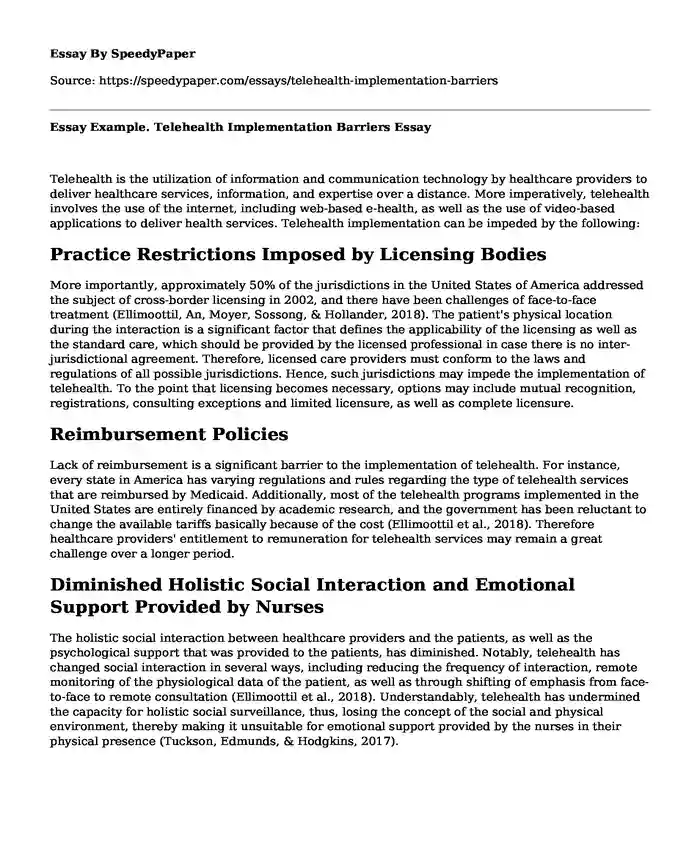
| Type of paper: | Essay |
| Categories: | Internet Information technologies Healthcare |
| Pages: | 3 |
| Wordcount: | 582 words |
Telehealth is the utilization of information and communication technology by healthcare providers to deliver healthcare services, information, and expertise over a distance. More imperatively, telehealth involves the use of the internet, including web-based e-health, as well as the use of video-based applications to deliver health services. Telehealth implementation can be impeded by the following:
Practice Restrictions Imposed by Licensing Bodies
More importantly, approximately 50% of the jurisdictions in the United States of America addressed the subject of cross-border licensing in 2002, and there have been challenges of face-to-face treatment (Ellimoottil, An, Moyer, Sossong, & Hollander, 2018). The patient's physical location during the interaction is a significant factor that defines the applicability of the licensing as well as the standard care, which should be provided by the licensed professional in case there is no inter-jurisdictional agreement. Therefore, licensed care providers must conform to the laws and regulations of all possible jurisdictions. Hence, such jurisdictions may impede the implementation of telehealth. To the point that licensing becomes necessary, options may include mutual recognition, registrations, consulting exceptions and limited licensure, as well as complete licensure.
Reimbursement Policies
Lack of reimbursement is a significant barrier to the implementation of telehealth. For instance, every state in America has varying regulations and rules regarding the type of telehealth services that are reimbursed by Medicaid. Additionally, most of the telehealth programs implemented in the United States are entirely financed by academic research, and the government has been reluctant to change the available tariffs basically because of the cost (Ellimoottil et al., 2018). Therefore healthcare providers' entitlement to remuneration for telehealth services may remain a great challenge over a longer period.
Diminished Holistic Social Interaction and Emotional Support Provided by Nurses
The holistic social interaction between healthcare providers and the patients, as well as the psychological support that was provided to the patients, has diminished. Notably, telehealth has changed social interaction in several ways, including reducing the frequency of interaction, remote monitoring of the physiological data of the patient, as well as through shifting of emphasis from face-to-face to remote consultation (Ellimoottil et al., 2018). Understandably, telehealth has undermined the capacity for holistic social surveillance, thus, losing the concept of the social and physical environment, thereby making it unsuitable for emotional support provided by the nurses in their physical presence (Tuckson, Edmunds, & Hodgkins, 2017).
Possibilities for Overcoming Barriers to Telehealth Implementation
Surpassing the conundrum of reimbursement, the implementation process, the system, and the providers have realized the fundamental importance of using a smart telehealth strategy. For instance, the strategy would involve freeing up of capacity in the basic care practice through telehealth solutions for reduced margin visits and reduced acuity to enhance return on investments by allowing healthcare providers to focus on such issues. Additionally, the system should ensure that for each twenty minutes visit is substituted by two minutes of telehealth consultation, thereby accommodating more reimbursement patients who need immediate care. More importantly, the implementation of telehealth should allow for physical visits and consultations to enhance emotional support for the patients. Finally, the implementation of telehealth should ensure that more restrictions on licensing are minimized, and the government finances all telehealth initiatives.
References
Ellimoottil, C., An, L., Moyer, M., Sossong, S., & Hollander, J. E. (2018). Challenges and opportunities faced by large health systems implementing telehealth. Health Affairs, 37(12), 1955-1959. Retrieved from: https://www.healthaffairs.org/doi/abs/10.1377/hlthaff.2018.05099
Tuckson, R. V., Edmunds, M., & Hodgkins, M. L. (2017). Telehealth. New England Journal of Medicine, 377(16), 1585-1592. Retrieved from: https://www.nejm.org/doi/full/10.1056/NEJMsr1503323
Cite this page
Essay Example. Telehealth Implementation Barriers. (2023, Apr 03). Retrieved from https://speedypaper.net/essays/telehealth-implementation-barriers
Request Removal
If you are the original author of this essay and no longer wish to have it published on the SpeedyPaper website, please click below to request its removal:
- Biblical Worldview Essay Example for Free
- Influence of Social Media on Youths, Essay Samples
- Essay Example on the Spread of Western Classical Architecture (Victoria Hall, Singapore)
- Health Disparity Essay Sample: Diabetes amongst Latino Population in the United States
- Essay Example on the Stance of Music in the African American Culture
- Essay Example: Assessing the Severity of Substance Use
- Paper Example. Cold War and Change for the U.S from 1980 till Present
Popular categories




